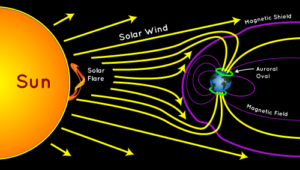About Coronal Mass Ejections (CMEs)
- The outer solar atmosphere, the corona, is structured by strong magnetic fields. Where these fields are closed, often above sunspot groups, the confined solar atmosphere can suddenly and violently release bubbles of gas and magnetic fields called coronal mass ejections.
- Coronal Mass Ejections (CMEs) are large expulsions of plasma and magnetic fields from the Sun’s corona. CMEs can result in “fluctuations of electrical currents in space and energize electrons and protons trapped in Earth’s varying magnetic field”
- They can eject billions of tons of coronal material and carry an embedded magnetic field (frozen in flux) that is stronger than the background solar wind interplanetary magnetic field (IMF) strength.
- CMEs travel outward from the Sun at speeds ranging from slower than 250 kilometers per second (km/s) to as fast as near 3000 km/s.
- The fastest Earth-directed CMEs can reach our planet in as little as 15-18 hours. Slower CMEs can take several days to arrive.
- They expand in size as they propagate away from the Sun and larger CMEs can reach a size comprising nearly a quarter of the space between Earth and the Sun by the time it reaches our planet.
Impact Of Coronal Mass Ejections (CMEs)
- The more explosive CMEs generally begin when highly twisted magnetic field structures (flux ropes) contained in the Sun’s lower corona become too stressed and realign into a less tense configuration – a process called magnetic reconnection.
- This can result in the sudden release of electromagnetic energy in the form of a solar flare; which typically accompanies the explosive acceleration of plasma away from the Sun – the CME.
- These types of CMEs usually take place from areas of the Sun with localized fields of strong and stressed magnetic flux; such as active regions associated with sunspot groups. CMEs can also occur from locations where relatively cool and denser plasma is trapped and suspended by magnetic flux extending up to the inner corona – filaments and prominences. When these flux ropes reconfigure, the denser filament or prominence can collapse back to the solar surface and be quietly reabsorbed, or a CME may result.
- CMEs travelling faster than the background solar wind speed can generate a shock wave.These shock waves can accelerate charged particles ahead of them – causing increased radiation storm potential or intensity.
Auroras
- When charged particles from a CME reach areas near Earth, they can trigger intense lights in the sky, called auroras.
- If you’re near the North Pole, it is called an aurora borealis or northern lights. If you’re near the South Pole, it is called an aurora australis or the southern lights.
What makes this happen?
- The Sun sends us more than heat and light; it sends lots of other energy and small particles our way.
- The protective magnetic field around Earth shields us from most of the energy and particles.
- But the Sun doesn’t send the same amount of energy all the time.During one kind of solar storm called a coronal mass ejection, the Sun burps out a huge bubble of electrified gas that can travel through space at high speeds.
- When a solar storm comes toward us, some of the energy and small particles can travel down the magnetic field lines at the north and south poles into Earth’s atmosphere.
- There, the particles interact with gases in our atmosphere resulting in beautiful displays of light in the sky. Oxygen gives off green and red light. Nitrogen glows blue and purple.

Source: The Hindu and swpc.noaa.gov
















